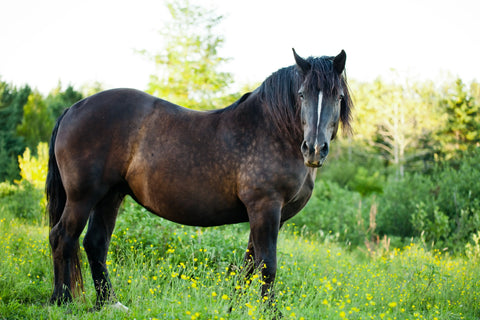
Arabian Horse: Everything You Need to Know About This Exceptional Breed
of reading - words
Where does the Purebred Arabian come from? 🏇
Its origin in the Arabian Peninsula
The Thoroughbred Arabian is one of the oldest horse breeds. Its origin dates back more than 4,000 years, in the deserts of the Arabian Peninsula. The Bedouins selected these horses for their resistance, endurance and intelligence.
His original environment, arid and demanding, shaped a horse strong, agile and energy efficient. He had to survive on little water and food, while traveling long distances.
The nomadic tribes raised these horses by sheltering them in their tents. This proximity has forged a unique bond between man and animal, influencing its docile and loyal character.
Its role in Bedouin and Arab civilizations
The Thoroughbred Arabian was much more than just a horse. He was a symbol of wealth, prestige and power.
The tribal leaders exchanged the best specimens as dowry or diplomatic gifts. Each line was carefully preserved to guarantee purity and performance.
He was also a formidable war horse. Fast and enduring, it allowed Arab horsemen to carry out lightning attacks before disappearing into the desert. His agility and speed made him a major strategic asset.
Its introduction to Europe and influence on other races
The crusades marked the entry of the Thoroughbred Arabian into Europe. European knights, impressed by the speed and endurance of these horses, brought them back to their kingdoms.
This horse then transformed European breeding. It was crossed with local breeds to improve the speed, endurance and elegance of many horses:
- English Thoroughbred (racing)
- Lusitano and Andalusian (dressage)
- Lipizzan (high school)
Its genetic influence is present in the majority of modern breeds, particularly those intended for racing and demanding equestrian disciplines.

Why is the Purebred Arabian an emblematic breed? 🐴
Its status in Arab culture and traditions
In Arab culture, the Thoroughbred Arabian is much more than a horse: it is a symbol of nobility, pride and honor.
The Arab poets and writers sang of her beauty and bravery. It is mentioned in many ancient texts, including the Quran, where it is described as a divine creation endowed with exceptional qualities.
Even today, in the countries of the Middle East, the Thoroughbred Arabian is celebrated through elegance and breeding competition. The purest bloodlines are selling at record prices, notably in the United Arab Emirates and Saudi Arabia.
Its prestigious lineages and its global influence
The Thoroughbred Arabian is distinguished by its precious genetic lines, preserved for centuries.
The most famous:
- Koheilan: powerful and muscular, often used to enhance other races.
- Siglavy: refined, appreciated for its elegance.
- Dahman: rare and prized for its perfect morphological balance.
- Muniqi: fast and nervous, ideal for racing.
Today, the Thoroughbred Arabian is present all over the world. He dominates endurance races, excels in horse shows, and remains a sought-after companion for leisure riding and long-distance trail rides.
Its genetic and cultural heritage makes it a unique breed, both precious and timeless.

What are the morphological particularities of the Purebred Arabian? 🐎
Ideal height, weight and proportions
The Thoroughbred Arabian is a medium sized horse, but its power and endurance surpass those of many larger breeds.
- Height: Between 1.45 m and 1.60 m at the withers
- Weight: From 350 to 450 kg, lighter than most saddle horses
- Proportions: Fine but dense bones, lean and well-defined muscles
Its compact and balanced physique optimizes its resistance over long distances, limiting muscle fatigue.
Morphology: thin head, arched neck, raised tail
The Thoroughbred Arabian has a unique morphology, immediately recognizable.
- Short, concave head with a slightly recessed chamfer
- Large, expressive eyes, often black and set wide apart
- Wide and open nostrils, promoting better oxygenation during exercise
- Long and elegantly arched neckline, marking its noble bearing
- Short and robust back, reinforcing its agility
- High tail and carried raised, distinctive sign of the breed
These characteristics give it an airy and harmonious look, reinforcing its aesthetic and expressiveness.
Most common dresses and markings
The Thoroughbred Arabian presents a palette of sober and classic coats, adapted to the warm climates where he comes from.
- Gray: The most common, representing approximately 50% of adult subjects
- Bai: Present in many ancient lineages
- Chestnut: Less common but very appreciated for its shine
- Black: Rare, but sought after for its presence
White markings on the head and limbs are common, but the breed does not accept piebald or excessively marked coats.

Temperament and behavior of the Purebred Arabian
An intelligent horse close to man
The Thoroughbred Arabian develops a strong bond with its rider. Historically raised as close as possible to humans, it is attentive, affectionate and expressive.
His intelligence allows him to quickly understand requests, but also to feel the emotions of his rider. Training based on confidence and gentleness gives the best results.
Sensitivity and learnability
The nervous sensitivity of the Purebred Arabian makes it a reactive horse. Its learning is based on observation and repetition. It memorizes quickly, but requires a consistent approach.
- Responds well to fine aids
- Adapts its behavior according to its environment
- Does not tolerate brutality or inconsistency in the work
Her energy and vivacity require a gentle but assured hand to channel her potential.
Adaptability: is it suitable for beginner riders?
The Thoroughbred Arabian may be suitable for beginners under certain conditions. His intelligence and sensitivity make him a pleasant, but also demanding, horse.
- A young horse requires an experienced rider
- A well-educated Thoroughbred Arabian is suitable for trail riding and endurance
- Its responsiveness requires flexible and precise mounting
He is not the typical school horse, but a respectful and patient rider can make him a loyal and successful partner.
What are the care and feeding needs?
Power supply: specific needs and mistakes to avoid
The Thoroughbred Arabian has efficient digestion, adapted to the desert conditions of its origins. His metabolism requires a balanced diet to maintain his energy and his muscles.
Recommended diet:
- Quality fodder (hay, grass): Basis of its diet, ensures good intestinal transit.
- Cereals (barley, oats, corn): Sources of energy, to be dosed according to physical activity.
- Mineral and vitamin supplements: Essential to prevent deficiencies, especially calcium and phosphorus.
Mistakes to avoid:
- Excess of cereals: Risk of colic and metabolic disorders.
- Food low in fiber: Weakens digestion and increases stress.
- Limited access to water: Insufficient hydration affects performance and health.
Health: common illnesses and prevention
The Thoroughbred Arabian is robust, but certain pathologies require particular vigilance.
Common diseases:
- Colic: Digestive sensitivity, especially in the event of a sudden dietary change.
- Polysaccharide storage myopathy (PSSM): Affects the muscles, linked to a diet too rich in starch.
- Equine metabolic syndrome (EMS): Predisposition to excess weight and insulin resistance.
Prevention:
- Split meals to limit insulin peaks.
- Monitor weight to avoid metabolic pathologies.
- Regular deworming and vaccination against parasitic and viral diseases.
Life expectancy and factors that influence it
The Thoroughbred Arabian has a high life expectancy, often exceeding 30 years, thanks to its endurance and its natural resistance.
Factors influencing longevity:
- Adapted diet: Avoids metabolic and digestive disorders.
- Regular exercise: Preserves joints and muscle tone.
- Rigorous veterinary monitoring: Allows early detection of health problems.
A Well-maintained Thoroughbred Arabian remains active and efficient even after 20 years.

Breeding and reproduction of the Purebred Arabian
How to select a good breeder?
A Quality Purebred Arabian must meet several criteria before being used for breeding.
Essential criteria:
- Verified genetic origin: Traceability of lines to guarantee purity.
- Morphology conforms to the standard: Short back, thin head, strong limbs.
- Balanced temperament: Intelligence, sensitivity and trainability.
- Proven sports performance: Results in endurance, running or body shape competitions.
Breeders look for breeders who transmit their qualities to their offspring, while avoiding hereditary defects.
The most sought-after bloodlines
Certain Thoroughbred Arabian bloodlines are particularly prized for their performance and morphology.
Famous bloodlines:
- Koheilan: Powerful, muscular, used to improve sporting breeds.
- Siglavy: Elegant, fine, appreciated in equestrian shows.
- Dahman: Balanced and harmonious, ideal for dressage and endurance.
- Muniqi: Fast and nervous, sought after for racing.
These lines influence world breeding and set the standards of the breed.
Price and cost of maintaining a Thoroughbred Arabian
The price of a Thoroughbred Arabian varies according to several criteria: age, lineage, level of training and performance.
Average price:
- Unbroken foal: Between 3,000 and 10,000 €
- Adult Purebred Arabian with good pedigree: 10,000 to 50,000 €
- Prestigious lines or competition horses: 50,000 to several hundred thousand euros
Annual maintenance cost:
| Expenses | Estimated annual cost |
|---|---|
| Power | 1,500 - 3,000 € |
| Veterinary care (vaccinations, deworming, check-ups) | 500 - 1,500 € |
| Farriery costs (shoeing, trimming) | 600 - 1,200 € |
| Equine health insurance | 300 - 800 € |
| Stable boarding | 2,000 - 6,000 € |
cost-effective choice for enthusiasts and professionals.

Mistakes to avoid with a Thoroughbred Arabian
Dressage: common rider errors
The Thoroughbred Arabian is intelligent, but also sensitive and responsive. A brutal or inconsistent approach generates stress and incomprehension.
Common errors:
- Lack of patience: Too intensive training can damage it.
- Lack of clear framework: This intelligent horse exploits the loopholes in education.
- Too many physical constraints: His short back and thin limbs require progressive work.
- Ignoring his need for variety: He gets bored quickly with repetitive exercises.
Dressage based on gentleness, consistency and gradual progression promotes a confident and efficient horse.
Maintenance: what not to neglect
The Thoroughbred Arabian does not tolerate approximation in its maintenance.
Key points:
- Food too rich in starch: Risk of metabolic disorders.
- Lack of exercise: This breed needs daily movement.
- Insufficient grooming: Its thin skin requires regular care to avoid irritation.
- Social isolation: This horse enjoys the company of its peers.
A rigorous management ensures its health and longevity.
How to properly manage your energy and temperament?
The Thoroughbred Arabian is full of energy. structured work allows you to channel this liveliness.
Effective strategies:
- Daily exercise : work mounted or in freedom to avoid excessive excitation.
- Varied work : alternation between dressage, exterior and playful exercises.
- Calm up and posed : a hand too hard or an insistent leg accentuates its nervousness.
This horse does not ask to be Brime , but Channel intelligently .
Opinion and testimonies of owners
The advantages and disadvantages according to the riders
Advantages:
✔ Dressing, hiking.
✔ Intelligence and reactivity : Facilitates learning.
✔ : can remain active after 20 years.
✔ strong link with humans : Faithful and endearing.
Disadvantages:
❌ : badly suited to brutal riders.
❌ requires rigorous management : food, care, mental work.
❌ can be unpredictable : reacts quickly to its environment.
Experiences in competition and leisure
The Endurance horsemen appreciate its Rapid recovery and its exceptional endurance . By hiking, its Sure foot and its resistance allow long distances with Less fatigue than other races.
In dressage and show jumping, he displays a Great flexibility , but his specialized sports horses.
Is the Arabic thoroughbred for you? (Interactive section)
A Arabic thoroughbred Suitable for a rider:
✅ calm and patient
✅ Ready to invest in his education
✅ practicing outdoor horse riding or endurance
Il not suitable If you are looking for:
❌ A Passe-Partout Club Horse
❌ A tolerant horse for beginner's errors = A horse requiring little maintenance and mental stimulation
If you have already mounted a Arabic thoroughbred , Share your experience!









